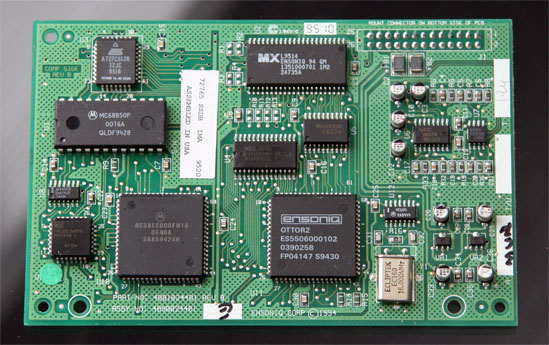The most important thing, when it comes to choosing a sound card, is the number of games that support it. It doesn't matter how impressive the specs of the card are if the game won't work with the card or use those features. I would like to concentrate on several important issues:
Sound Blaster Pro Compatibility
Very few cards are truly "Sound Blaster Pro" compatible. The Sound Blaster Pro 1.0 has three major components, the dual OPL2 chips, the 1345 Mixer Chip and the 1341 DSP chip. For stereo programming, each of these components act differently than their later replacements in important ways. Even the Sound Blaster Pro 2.0, while sharing the same mixer and DSP, loses two FM voices to the OPL2 chips. Sound Blaster 16s lose some of the DSP modes of the Sound Blaster Pros and Sound Blaster 2.0. The Mixer chips handle stereo differently enough that a game programmed for the Sound Blaster Pro will not work in stereo on the Sound Blaster 16. The Sound Blaster Pro is truly downard compatible in its OPL and DSP with the Sound Blaster 1.0-1.5 (Non-Pro Sound Blasters don't have Mixers.)
Sound Blaster 16 Compatibility
The Sound Blaster 16s are more advanced than the Sound Blaster Pros, but share similar functional components, a 1745 Mixer Chip, a 1741 DSP and a OPL3 chip. Later Creative cards, beyond the 17x0 series, lack one or more of the chips, sometimes condensing their functionality into ASICs, othertimes emulating them. A card cannot be truly Sound Blaster 16 compatible unless it possesses all three components. Vibra chips and cards lack the Mixer chip and its functionality, and no AWE card has a true OPL3 chip. Not many ISA cards explicitly state that they are Sound Blaster 16 compatible, and those Sound Cards that do only offer basic emulation.
True Yamaha OPL Chips
A card boasting that it is Adlib or Sound Blaster compatible must have one or two OPL2 or one OPL3 chips on the card. The chips must be Yamaha chips, YM-3812 and YMF-262, respectively. Nothing else, except an Yamaha OPL4 chip, on a sound card will accurately reproduce the sounds of these chips. A single OPL3 chip can, excpet for the most demanding programmers, be able to replace a single OPL2 chip, but cannot quite reach the level of voices that dual OPL2 chips of the Sound Blaster Pro 1.0 and the Pro Audio Spectrum can provide. Cards like the Gravis Ultrasound and PCI cards usually try to emulate the OPL chips with some help from their wavetable capabilities.
MPU-401 Compatibility
Early games that support the Roland MT-32 Sound Module and its derivatives expect to communicate to the device through a Roland midi interface. All Roland ISA midi interfaces and the LAPC-I Sound Card support Intelligent midi as well as UART midi processing, and games often rely on the particular features of the intelligent midi mode to ensure their data passed through to the MT-32 safely. Devices supporting the Roland SCC-1 Sound Card also sometimes require intelligent midi mode. Games that support General Midi only require UART compatibility. While the Sound Blaster 16 is UART compatible, the compatibility is quite buggy and should never be used if you possess a true Roland midi interface. If you have such an interface, the only time you should use the Sound Blaster for midi communications is if the game only supports the old Sound Blaster midi standards. Few do.
General Midi, Roland GS, Yamaha XG
It is important to note that these sound standards refer to the particular capabilities and specifications of the sound producing device. Roland GS and Yamaha XG support more voices and drum kits than General Midi, but both are downwards compatible. If you only have a General Midi option in your game, you can use either a Roland GS or Yamaha XG device, and either would likely sound better than a General Midi-only device. Yamaha XG is downward compatible with Roland GS to an extent but is no substitute for a Roland GS device. I would not recommend using any "GS compatible" device other than true Roland manufactured products, and for Yamaha XG devices, use only the following cards or daughterboards: SW60XG, SW1000XG, DB50XG, DB51XG, DB60XG. Be careful, as Yamaha also introduced several inferior PCI XG cards.
Roland MT-32 Compatibility
A favorite marketing phrase Sound Card manufacturer's liked to tout was their MT-32 compatibility. Now, the basic circuitry of an MT-32 takes a half-sized ISA board to properly replicate. Even though a manufacturer may have MT-32 tones in its patch set, it takes more than that to replicate the MT-32's sound. Only a true MT-32 or Multi-Timbral LA Synthesis device can properly set the parameters or use custom patches. Nothing else, even Roland's Sound Canvas MT-32 variation set, comes close to the real thing. Once you have experienced it, you never want to go back.
